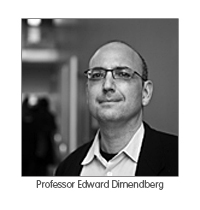Making the Past Tangible: An Interview with Professor Edward Dimendberg
Professor Dimendberg approached Special Collections and Archives last summer about the possibility of collaborating on a new class, Film and Media Studies 114: The Book as Medium, for the Fall 2011. The  class was quite successful and provided unique learning experiences to everyone involved. We asked Professor Dimendberg a few questions about his class.
class was quite successful and provided unique learning experiences to everyone involved. We asked Professor Dimendberg a few questions about his class.
Q. Why did you decide to teach your course "The Book as Medium"?
Today many of my colleagues in the film and media studies field have declared the Internet to be the catalyst of the greatest media and communications revolution in human history. I find much of this rhetoric overblown and decided to expose students to the histories of writing, the book, and printing, the first major transformations in media history.
Q. What is the course subject matter?
Most of the class has involved reading studies of the shift from orality to writing and print culture. We have concentrated on classic analyses by Walter Ong, Lucien Febvre, Marshall McLuhan, Robert Darnton, and Elizabeth Eisenstein. During the final two weeks of the course we consider the future of reading and the book itself. Along the way, we have watched some films about book history and publishing.
Q. How did you integrate visits to Special Collections into the course?
Steve MacLeod and I met to discuss options for visits to Special Collections. Steve provided me with a list of possible materials for students to study. From that list, I assigned each student a manuscript or book in Special Collections on which to report. They range from a hand-copied 15th century Catholic breviary, to Shakespeare's First Folio, to Diderot's Encyclopedia, to a 19th-century natural science text. Students analyze the genre, history, and function of the book and present what can be known about it. Student presentations took place in the library over three sessions, with Steve assisting.
Q. Did these visits prove helpful?
I knew that for most students books in Special Collections would be the oldest objects that they had handled, yet I was not prepared for the excitement that their encounter with them would generate. The challenge of trying to understand something completely foreign to their experience yet absolutely tangible has been rewarding for them and for me. The collaboration with the library was fabulous. In fourteen years of teaching, I seldom have felt as rewarded as I did after these sessions.
Q. Were there any surprises?
I quickly realized that it is impossible to study the history of the book without encountering questions about accessibility, readership, format, and piracy, the same questions that turn up in the contemporary discussions of electronic books. Contemporary debates have a long and fascinating history. I can't wait to teach this course again.
Q. Why do you think the Libraries should continue to acquire, preserve and provide access to rare books and manuscripts, in particular for undergraduate students?
Graduate students are trained to work with manuscripts and original sources. Undergraduates typically have no exposure to these materials. When they do encounter them, it usually precipitates an intense learning experience. Rare books and manuscripts make the past tangible.
For more information about this class or to discuss possibilities for your classes, please contact Steve MacLeod, Public Services Librarian, Special Collections and Archives,(x44967 or smacleod@uci.edu).

